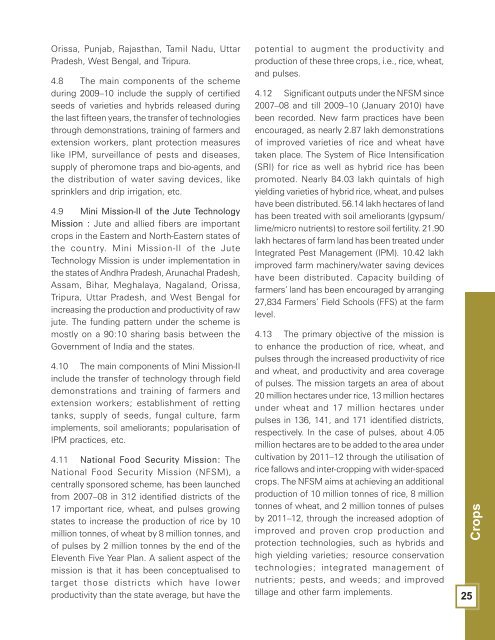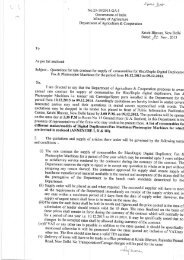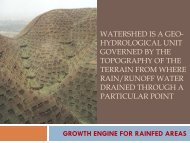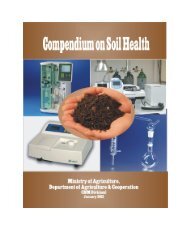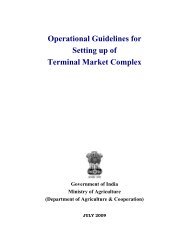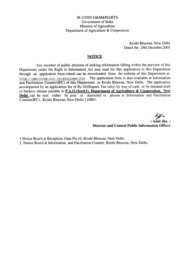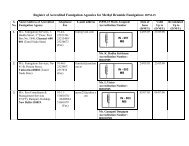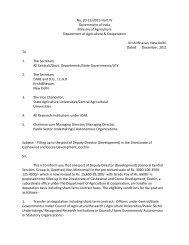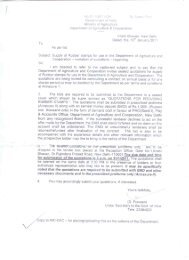Annual Report 2009-2010 - Department of Agriculture & Co-operation
Annual Report 2009-2010 - Department of Agriculture & Co-operation
Annual Report 2009-2010 - Department of Agriculture & Co-operation
You also want an ePaper? Increase the reach of your titles
YUMPU automatically turns print PDFs into web optimized ePapers that Google loves.
Orissa, Punjab, Rajasthan, Tamil Nadu, Uttar<br />
Pradesh, West Bengal, and Tripura.<br />
4.8 The main components <strong>of</strong> the scheme<br />
during <strong>2009</strong>–10 include the supply <strong>of</strong> certified<br />
seeds <strong>of</strong> varieties and hybrids released during<br />
the last fifteen years, the transfer <strong>of</strong> technologies<br />
through demonstrations, training <strong>of</strong> farmers and<br />
extension workers, plant protection measures<br />
like IPM, surveillance <strong>of</strong> pests and diseases,<br />
supply <strong>of</strong> pheromone traps and bio-agents, and<br />
the distribution <strong>of</strong> water saving devices, like<br />
sprinklers and drip irrigation, etc.<br />
4.9 Mini Mission-II <strong>of</strong> the Jute Technology<br />
Mission : Jute and allied fibers are important<br />
crops in the Eastern and North-Eastern states <strong>of</strong><br />
the country. Mini Mission-II <strong>of</strong> the Jute<br />
Technology Mission is under implementation in<br />
the states <strong>of</strong> Andhra Pradesh, Arunachal Pradesh,<br />
Assam, Bihar, Meghalaya, Nagaland, Orissa,<br />
Tripura, Uttar Pradesh, and West Bengal for<br />
increasing the production and productivity <strong>of</strong> raw<br />
jute. The funding pattern under the scheme is<br />
mostly on a 90:10 sharing basis between the<br />
Government <strong>of</strong> India and the states.<br />
4.10 The main components <strong>of</strong> Mini Mission-II<br />
include the transfer <strong>of</strong> technology through field<br />
demonstrations and training <strong>of</strong> farmers and<br />
extension workers; establishment <strong>of</strong> retting<br />
tanks, supply <strong>of</strong> seeds, fungal culture, farm<br />
implements, soil ameliorants; popularisation <strong>of</strong><br />
IPM practices, etc.<br />
4.11 National Food Security Mission: The<br />
National Food Security Mission (NFSM), a<br />
centrally sponsored scheme, has been launched<br />
from 2007–08 in 312 identified districts <strong>of</strong> the<br />
17 important rice, wheat, and pulses growing<br />
states to increase the production <strong>of</strong> rice by 10<br />
million tonnes, <strong>of</strong> wheat by 8 million tonnes, and<br />
<strong>of</strong> pulses by 2 million tonnes by the end <strong>of</strong> the<br />
Eleventh Five Year Plan. A salient aspect <strong>of</strong> the<br />
mission is that it has been conceptualised to<br />
target those districts which have lower<br />
productivity than the state average, but have the<br />
potential to augment the productivity and<br />
production <strong>of</strong> these three crops, i.e., rice, wheat,<br />
and pulses.<br />
4.12 Significant outputs under the NFSM since<br />
2007–08 and till <strong>2009</strong>–10 (January <strong>2010</strong>) have<br />
been recorded. New farm practices have been<br />
encouraged, as nearly 2.87 lakh demonstrations<br />
<strong>of</strong> improved varieties <strong>of</strong> rice and wheat have<br />
taken place. The System <strong>of</strong> Rice Intensification<br />
(SRI) for rice as well as hybrid rice has been<br />
promoted. Nearly 84.03 lakh quintals <strong>of</strong> high<br />
yielding varieties <strong>of</strong> hybrid rice, wheat, and pulses<br />
have been distributed. 56.14 lakh hectares <strong>of</strong> land<br />
has been treated with soil ameliorants (gypsum/<br />
lime/micro nutrients) to restore soil fertility. 21.90<br />
lakh hectares <strong>of</strong> farm land has been treated under<br />
Integrated Pest Management (IPM). 10.42 lakh<br />
improved farm machinery/water saving devices<br />
have been distributed. Capacity building <strong>of</strong><br />
farmers’ land has been encouraged by arranging<br />
27,834 Farmers’ Field Schools (FFS) at the farm<br />
level.<br />
4.13 The primary objective <strong>of</strong> the mission is<br />
to enhance the production <strong>of</strong> rice, wheat, and<br />
pulses through the increased productivity <strong>of</strong> rice<br />
and wheat, and productivity and area coverage<br />
<strong>of</strong> pulses. The mission targets an area <strong>of</strong> about<br />
20 million hectares under rice, 13 million hectares<br />
under wheat and 17 million hectares under<br />
pulses in 136, 141, and 171 identified districts,<br />
respectively. In the case <strong>of</strong> pulses, about 4.05<br />
million hectares are to be added to the area under<br />
cultivation by 2011–12 through the utilisation <strong>of</strong><br />
rice fallows and inter-cropping with wider-spaced<br />
crops. The NFSM aims at achieving an additional<br />
production <strong>of</strong> 10 million tonnes <strong>of</strong> rice, 8 million<br />
tonnes <strong>of</strong> wheat, and 2 million tonnes <strong>of</strong> pulses<br />
by 2011–12, through the increased adoption <strong>of</strong><br />
improved and proven crop production and<br />
protection technologies, such as hybrids and<br />
high yielding varieties; resource conservation<br />
technologies; integrated management <strong>of</strong><br />
nutrients; pests, and weeds; and improved<br />
tillage and other farm implements.<br />
Crops<br />
25


